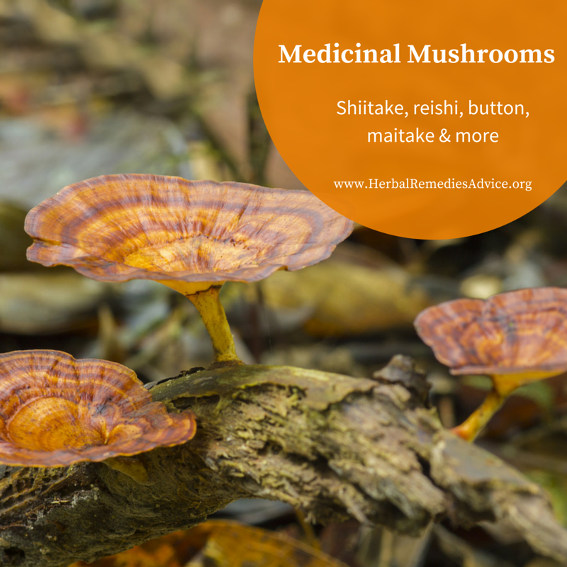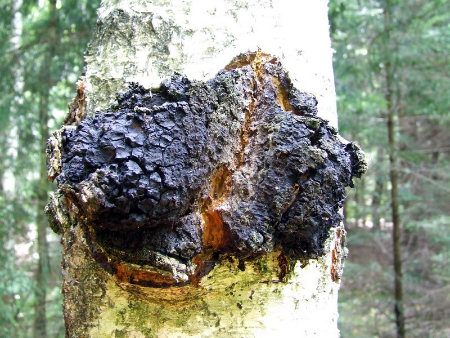Get weekly tips, recipes, and my Herbal Jumpstart e-course! Sign up for free today.

Herbal and Medicinal Mushrooms
Share this! |
|
Herbal and medicinal mushrooms are continually grabbing the spotlight for their incredible health benefits, ranging from cancer prevention and treatment, to being antiviral, to curing asthma and even prolonging life.
Type in any of the medicinal mushrooms listed below into a PubMeddatabase and you’ll see countless scientific studies validating their use as medicine. But while science is looking in test tubes to substantiate the medicinal value of mushrooms, people around the world have been using these fungi to improve their health for thousands of years.
But what are these strange creatures anyway? Placed in their own kingdom (fungi), mushrooms are the fruiting bodies of mycelium. Mycelium is an organism present in most healthy soils. It forms a dense web underneath the soils where it conducts a multidirectional transfer of nutrients between plants and itself. According to Stamets, in one cubic inch of soil there can be 8 miles of mycelium. The fascinating study of mycelium and its ability to break down and transform materials, even toxic materials, goes beyond the scope of this article, but one I highly suggest looking into.
Mycoremediation, which could help reduce toxic materials presently related to disposal facilities, help decontaminate and minimize road and farm runoff, creates buffer zones, reduces agricultural waste, reduces pollution in watersheds, reduces the risk of forest fire, and cleans up contaminated pathogenic bacteria such as Escherichia coli. - Robert Dale Rogers
Herbal and Medicinal Mushrooms Identification
In the early years of HerbMentor.com John and I always said we would never feature medicinal mushrooms on the site. While mushrooms are certainly a valid medicine we felt that a person really needed to learn how to identify mushrooms from an expert in person. And although we still feel that way, we decided to feature herbal and medicinal mushrooms that can be found in commerce. As a result, this article is not about identifying wild medicinal mushrooms. It is about using medicinal mushrooms bought from herbal apothecaries or even your grocery store. Just recently, my father-in-law was hospitalized and came close to dying from eating a misidentified mushroom. It’s not something to fool around with!
When purchasing mushrooms always buy organic. Conventional mushrooms, especially those sold in grocery stores, are routinely sprayed with a myriad of pesticides.
Historical Use of Herbal and Medicinal Mushrooms
People have used mushrooms medicinally and as food for thousands of years. The oldest written reference to people using mushrooms medicinally is from an Ayurvedic source from 5000 BP.
The Chinese have one of the most sophisticated uses of herbal and medicinal mushrooms and have a written history of using them that dates back several thousand years as well. Many medicinal mushrooms like cordyceps and reishi were so highly prized (and so very rare) that only the emperor was allowed to consume them. Now these mushrooms are cultivated and are often times affordable.
The Greeks and Romans ate mushrooms frequently. The Greeks said mushrooms were the “food of the gods.”
General Characteristics of Herbal and Medicinal Mushrooms
We believe there is over 1.4 million species of mushrooms on earth, but only 10% have been scientifically named and catalogued.
All herbal and medicinal mushrooms contain beta-D-glucan, which is a type of polysaccharide. These chemical constituents are commonly found in some plant cellulose (Astragalus, Echinacea, etc) and fungi. They have been studied extensively for their ability to modulate the immune system. Much of the modern scientific research done on mushrooms is related to cancer prevention and treatment, HIV and AIDS, and other immune function disorders.
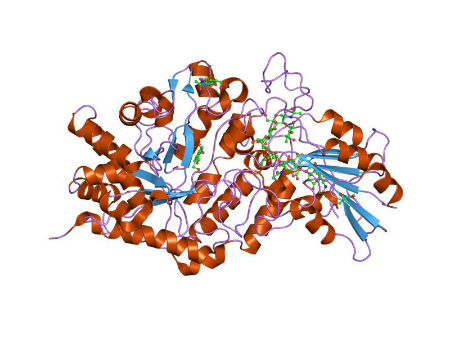 Beta D-glucan
Beta D-glucanThere are lots of different ways to prepare herbal and medicinal mushrooms. They can be cooked into food, made into a tea or decoction or syrup, or powdered and taken as capsules. Another method is to decoct the mushrooms and then add 20% alcohol to the water extraction to preserve it.
Christopher Hobbs recommends first extracting the mushrooms in 50% alcohol (using normal tincture methods), then straining that mixture and placing the marc (mushrooms) into a pan to simmer with 5 parts water to the mushroom volume. This is simmered for an hour and then strained. The water is then simmered again until it is reduced to 1/5 of its original volume. This is then added to the original extract in a quantity that leaves 20% alcohol in the final product.
Some Common Herbal and Medicinal Mushrooms
In this section we’ll look more closely at some common herbal and medicinal mushrooms that are readily available in commerce.
Common Button Mushroom (Agaricus bisporus)
That’s right, the lowly common mushrooms readily found in your grocery store are medicinal mushrooms! The use of these dates back at least to 1700 BP where it was described in a Byzantine treatise.
This is the most commonly consumed and cultivated mushroom worldwide. It is native to grasslands in Europe and North America.
There are over 300 different Agaricus species and some are edible while some are poisonous. Portabellas, another common edible mushroom found in the grocery store, are also a part of this genus.
Another species, A. campestris, was used by Nicholas Culpeper, an infamous herbalist who lived from 1616 – 1654. He says “Roasted and applied in a poultice, or boiled with white lily roots and linseed in milk, they ripen boils and abscesses better than any preparation that can be made.”
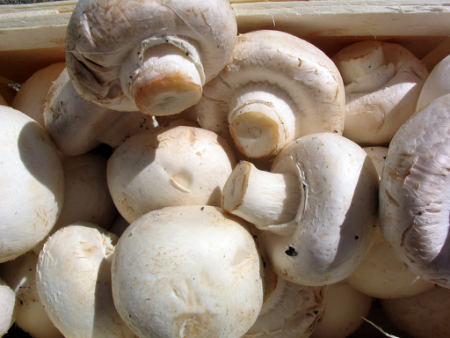 Agaricus bisporus
Agaricus bisporus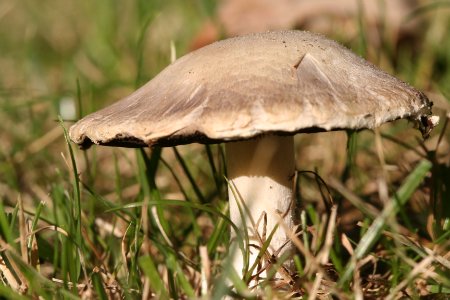 Agaricus campestris
Agaricus campestrisIn China, mushrooms in this genus have been used for hypertension as well as in formulas for low back pain and tendon pain.
Like other herbal and medicinal mushrooms they have been studied extensively as a tool against various cancers and have shown promising results.
Since they are found so readily in stores, these make an easy addition to the diet. Just remember to buy them organically and to cook them.
Shiitake (Lentinula edodes)
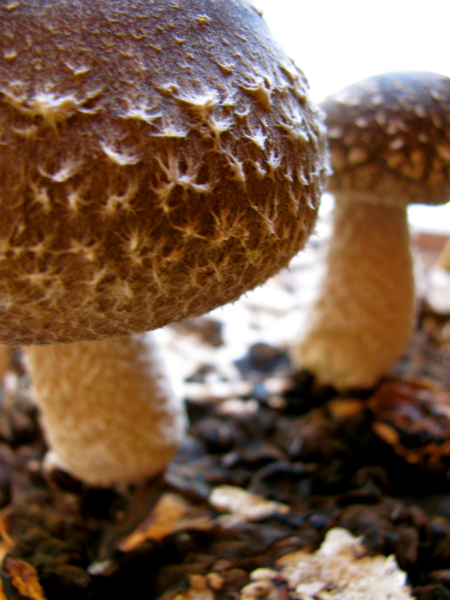 Homegrown Shiitake Mushrooms
Homegrown Shiitake MushroomsShiitake mushrooms originate in Japan, China and other Asian countries with temperate climates where they have been enjoyed as food and medicine for thousands of years.
They are now the second most cultivated mushroom in the world and can often be found in grocery stores. Growing your own is easy (look for shiitake mushroom kits online) and results in the best shiitakes I’ve ever eaten. In our household we eat shiitake mushrooms a couple times a week. They are wonderful in soups or simply sauteed with garlic and butter.
Shiitakes grown in nutrient-dense soils produce nutrient-dense fruits. They can be especially high in potassium, calcium, phosphorous, proteins and magnesium.
These mushrooms have been studied extensively for their immunomodulating effects. Most studies, however, have been conducted using concentrated isolated chemical constituents of shiitakes and not the whole mushroom. So while we know that these concentrated constituents have produced remarkable clinical results, we don’t always know that those same results can be achieved by simply eating the mushrooms or as a whole extract (as a tea or decoction).
We do know that shiitake mushrooms are beneficial against cancer, not because they attack the cancer cells but because they enhance a person’s immune system. This is the reason they can also be helpful for someone experiencing frequent colds and flus and seasonal allergies. Shiitake has also been shown to inhibit both herpes simplex 1 and 2.
Shiitakes have been shown to promote cardiovascular health as well by optimizing lipid levels.
Shiitake mushrooms are classified as a sweet taste with mild actions. They are considered building and strengthening in Traditional Chinese Medicine.
Like all mushrooms, shiitake mushrooms should be fully cooked before consuming, as a small number of people can develop an itchy rash from consuming them raw. Christopher Hobbs says common dosages of the whole fruiting body are 6-16 grams of dried mushrooms or 90 grams of fresh mushrooms.
Reishi (Ganoderma lucidum)
Reishi has long been heralded as the elixir of life. Traditional Chinese Medicine (TCM) considers it to be in the highest class of tonics to promote longevity. This is the first medicinal substance to be written about by the Chinese and entire books have been written about this single mushroom!
This mushroom is well proven to prevent and combat cancer and other immune system disorders. It has beneficial effects on the liver, helping both to regenerate and protect it. It’s also been shown to reduce fatty deposits on the liver. It has multiple benefits for the heart, helping to normalize cholesterol levels and regulate blood pressure.
In his book Medicinal Mushrooms, Christopher Hobbs outlines pharmacological effects of whole reishi extracts. These effects include: analgesic, anti-allergenic, anti-inflammatory, antibacterial, antioxidant, antitumor, antiviral, hypotensive, cardiotonic, relaxing nervine, expectorant and antitussive, anti-HIV, adaptogen, hepatoprotective and immunomodulating.
The studies done on reishi’s immunomodulating effects and its benefits against a variety of cancers, auto-immunity diseases and viral infections is absolutely dizzying! Lesley Tierra specifically recommends it combined with astragalus for people who have extreme food sensitivities.
Reishi can also oxygenate the blood, making it a useful ally against altitude sickness.
In
my experience, it [reishi] is especially suitable as a calming herb for
people with anxiety, sleeplessness, or nervousness accompanied by
adrenal weakness or general neurasthenia or deficiency syndromes. In
this regard, it is to be much preferred to traditional western sedative
herbs such as valerian, which could be too warm and actually stimulating
for some individuals.
-Chris Hobbs, Medicinal Mushrooms
This polypore mushroom is too hard to eat and is commonly taken as a decoction or used as a powdered herb. The typical dose is 3-15 grams. Lesley Tierra recommends breaking the mushroom into smaller pieces and then decocting 1 oz of reishi to one quart of water for 60 minutes. One cup can be drunk 2-3 times a day.
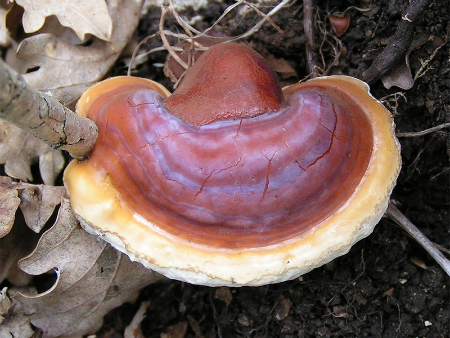 Reishi Mushroom
Reishi MushroomCordyceps (Ophiocordyceps sinensis)
Cordyceps are some of my favorite herbal and medicinal mushrooms, but admittedly probably the most freaky. This fungus invades a species of caterpillar that it eventually kills as the fruiting body erupts from the animal’s head. I told you it was freaky!
This mushroom is so highly sought after that the price of it per pound can reach into the tens of thousands of dollars. Luckily it is being cultivated in the Pacific Northwest and can be purchased at a much more reasonable price. (Buy high quality cordyceps powder at Mountain Rose Herbs.)
Traditionally, in China, cordyceps was consumed by first cooking it in a duck. Eating this meal is considered to be as potent as having a large amount of ginseng.
Cordyceps has been shown to be especially useful against lung cancers (in TCM it is said to enter through the Lung meridian). It is also used to increase libido, optimize cholesterol levels, address liver disease and to relax bronchial tissues, which is helpful for those with certain types of asthma.
Olympic athletes use cordyceps to increase their stamina. One week after I started taking cordyceps I was running up a steep hill that I had only been able to walk up previously. It’s currently being studied for a wide range of lung diseases.
Cordyceps can be taken as a tea, in capsules or cooked into duck. The typical dose is 5-12 grams.
Chaga (Inonotus obliquus)
Chaga is a parasite that grows on birch trees. Technically not a mushroom, just a mass of mycelium, it has been used in folk medicine for centuries, most notably in Russia. Science is now validating its use, showing immunostimulating properties and that it protects against oxidative stress. It is most famous for its use against a wide range of cancers, notably cancer of the breast, lip, skin and colon.
Chaga can be used as a decoction or as an alcohol extract. The decocted root is tasty and is sometimes called a “coffee substitute”.
Chaga (Inonotus obliquus) grows slowly on beech and birch trees over many years. Chaga is a non-sporulating (non-fertile) hardened structure with a dark, cracked over-crust. Some mycologists call Chaga an above-ground sclerotium. Chaga grows on living trees, taking many years for a soft-ball size structure to form. Once the tree dies, a resupinate crust forms on the ground near the tree. This is the spore-reproducing structure. What scientists do not know is whether or not the removal of Chaga will harm the formation of the spore producing crust. We do know that wild harvesting of Chaga is radically reducing this species populations. And since we can grow mycelium -sustainably- while retaining its beneficial properties, please refrain from harvesting wild chaga for commercial purposes. Thank you. Respectfully, Paul Stamets, www.fungi.com
Maitake (Grifola frondosa)
Maitake is another medicinal mushroom masquerading as a gourmet food. It has been studied extensively for breast cancer and has been shown to reduce tumor size and aggressiveness. Like shitake mushrooms, maitakes can easily be incorporated into your food frequently.
Turkey Tail (Trametes versicolor)
Turkey tails are frequently found growing on trees throughout the world. Although less studied than other herbal and medicinal mushrooms this one is well-worth looking into and not just for its health benefits. Paul Stamets (author of Mycelium Running and all-around mushroom extraordinaire) reports that it has bioremediation benefits and can help clean up toxic environments. The Chinese and Japanese have been using it as immune support therapy for cancer and Stamets claims to have cured his own mother of breast cancer using this mushroom.
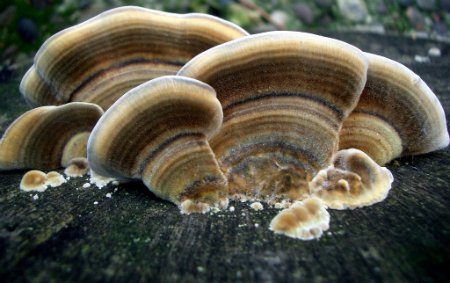 Turkey Tail Mushroom
Turkey Tail MushroomOyster mushroom (Pleurotus ostreatus)
This common edible mushroom has natural statins that help to regulate blood cholesterol. It is commonly found in the wild in temperate climates and in our grocery stores.
Herbal and medicinal mushrooms are continually proving themselves effective for combatting serious diseases like cancer. Even better, they can be consumed regularly to prevent chronic diseases from ever occurring.
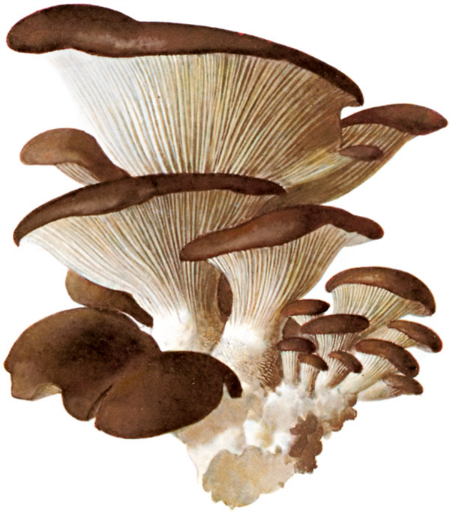 Oyster Mushroom
Oyster MushroomFurther Resources
- Paul Stamets on How Mycelium Can Save the World
- Interview with Robert Dale Rogers
- The Fungal Pharmacy: The Complete Guide to Medicinal Mushrooms and Lichens of North America by Robert Rogers
- Medicinal Mushrooms (Herbs and Health Series) by Christopher Hobbs
This article was originally written for www.herbmentor.com

Rosalee is an herbalist and author of the bestselling book Alchemy of Herbs: Transform Everyday Ingredients Into Foods & Remedies That Healand co-author of the bestselling book Wild Remedies: How to Forage Healing Foods and Craft Your Own Herbal Medicine. She's a registered herbalist with the American Herbalist Guild and has taught thousands of students through her online courses. Read about how Rosalee went from having a terminal illness to being a bestselling author in her full story here.
